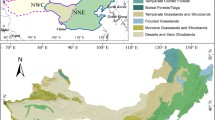Abstract
The Liupan Mountains is located in the southern Ningxia Hui Autonomous Region of China, which forms an important dividing line between landforms and bio-geographic regions. The populated part of the Liupan Mountains region has suffered tremendous ecological damages over time due to population pressure, excessive demand and inappropriate use of agricultural land resources. In this paper, datasets of land use between 1990 and 2000 were obtained from Landsat TM imagery, and then spatial models were used to characterize landscape conditions. Also, the relationship between the population density and land use/cover change (LUCC) was analyzed. Results indicate that cropland, forestland, and urban areas have increased by 44,186ha, 9001ha and 1550ha, respectively while the grassland area has appreciably decreased by 54,025ha in the study period. The decrease in grassland was most notable. Of the grassland lost, 49.4% was converted into cropland. The largest annual land conversion rate in the study area was less than 2%. These changes are attributed to industrial and agricultural development and population growth. To improve the eco-economic conditions in the study region, population control, urbanization and development of an ecological friendly agriculture were suggested.
Similar content being viewed by others
References
An Shaoshan, Li Bicheng, Hao Shilong, 2005. The theory and practice of the eco-agriculture models construction in semiarid degradation mountain area of Ningxia. Research of Soil and Water Conservation, 12(3): 19–21. (in Chinese)
Foley J A, DeFries A, Asner G P et al., 2005. Global consequences of land use. Science, 309: 570–574.
Guyuan District Statistics Department, 2002. Statistical Yearbook of Southern Ningxia (1949–1992). Beijing: China Statistics Press. (in Chinese)
He Chunyang, Zhou Haili, Yu Zhangtao et al., 2002. Regional land use/cover information processing. Resources Science, 24(2): 64–70. (in Chinese)
Lai Yanbin, Xu Xia, Wang Jin’ai et al., 2002 Analysis of LUCC pattern of physical region in NSTEC. Progress in Earth Sciences. 17(2): 215–220. (in Chinese)
Li Bicheng, Li Shengbao, 2005. The construction and demonstration of ecological agriculture in semiarid degradation mountainous areas. Research of Soil and Water Conservation, 12(3): 1–4. (in Chinese)
Li Shengbao, Jiang Qi, Li Bicheng, 2006. Study on Ecological Agricultural Construction Technology in the Southern Ningxia Mountainous Region. Yinchuan: Ningxia Peoples Publishing House. (in Chinese)
Li Xiubin, 2002. Impact on hydrolytic and water resource of land use and land cover change. In: Chinese Physical Geographical Specialized Committee. (ed.). Land Use/cover Change and Its Impact. Beijing: Global Map Press, 1–6. (in Chinese)
Liu Jiyuan, 1996. The Macro Investigation and Dynamic Research of the Resource and Environment. Beijing: China Science and Technology Press. (in Chinese)
Liu Jiyuan, Buhe Aoser, 2000. Study on spatial-temporal feature of modern land use change in China: Using remote sensing techniques. Quaternary Sciences, 20(3): 229–239. (in Chinese)
Liu Jiyuan, Zhang Zengxiang, Deng Xiangzhen, 2005. Spatio-temporal patterns and driving forces of urban land expansion in China during the economic reform era. Ambio, 34(6): 444–449. (in Chinese)
Liu Shenghe, He Shujing, 2002. A spatial analysis model for measuring the rate of land use change. Journal of Natural Resources, 17(5): 533–540. (in Chinese)
Matson P A, Parton W J, Power A G et al., 1997. Agricultural intensification and ecosystem properties. Science, 277(25): 504–509.
Meyer W B, Turner II B L, 1996. Land-use/land-cover change: Challenges for geographers. GeoJournal, 39(3): 237–240.
Quan Bin, Zhu Hejian, Chen Songlin et al., 2007. Land suitability assessment and land use change in Fujian Province, China. Pedosphere, 17(4): 493–504.
Quan Bin, Chen Jianfei, Qiu Honglie et al., 2006. Spatial-temporal pattern and driving forces of land use changes in Xiamen. Pedosphere, 16(4): 477–488.
Sheng Liangxi, 2002. Introduction to Modern Environment Sciences. Beijing: Chemical Industry Press. (in Chinese)
Turner II B L, 1994. Local faces, global flows: The role of land use and land cover in global environmental change. Land Degrad. Rehab., 5(2): 71–78.
Wang Siyuan, Zhang Zengxiang, Zhou Quanbin et al., 2002. Study on spatial-temporal features of land use/land cover change based ontechnologies of RS and GIS. Journal of Remote Sensing, 6(3): 223–228. (in Chinese)
Wang Xiulan, Bao Yuhai, 1999. Study on the methods of land use dynamic change research. Progress in Geography, 18(1): 81–87. (in Chinese)
Yang Shuhe, Yan Haili, Guo Liying, 2004. The land use change and its eco-environmental effects in transitional agro-pastoral region-A case study of Yulin City in Northern Shaanxi Province. Progress in Geography, 23(6): 49–55. (in Chinese)
Author information
Authors and Affiliations
Corresponding author
Additional information
Foundation item: Under the auspices of the National Key Science and Technology Support Program of China (No. 2006BCA01A07-2), National Natural Science Foundation of China (No. 40671153), Hunan Land Resource Bureau Program (No. 2007-15), Hunan Education Bureau Program (No. 08C348)
Rights and permissions
About this article
Cite this article
Quan, B., Römkens, M.J.M., Tao, J. et al. Spatial-temporal pattern and population driving force of land use change in Liupan Mountains region, southern Ningxia, China. Chin. Geogr. Sci. 18, 323–330 (2008). https://doi.org/10.1007/s11769-008-0323-y
Received:
Accepted:
Published:
Issue Date:
DOI: https://doi.org/10.1007/s11769-008-0323-y




